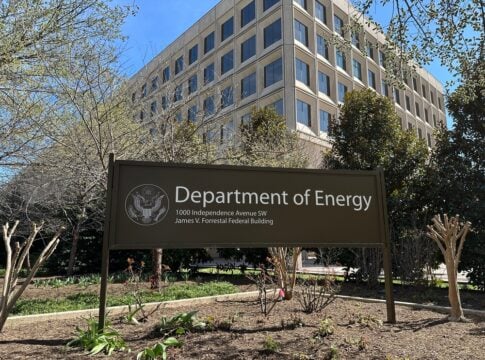Carbon credits are increasingly essential for investors and businesses aiming to reduce emissions. According to Abatable’s latest report, the voluntary carbon market (VCM) is growing rapidly, attracting $16.3 billion in funding in 2024.
This is 18 times higher than the total value of credit retirements, highlighting a shift toward long-term commitments rather than short-term carbon offset purchases. Compared to previous years, this represents a significant rise, underscoring the increasing role of carbon markets in corporate sustainability strategies.
Governments, companies, and investors are under pressure to integrate climate action into their operations. The European Union’s Carbon Border Adjustment Mechanism (CBAM), which places a tariff on carbon-intensive imports, is expected to drive higher demand for trusted carbon credits.
As regulations evolve globally, businesses that adopt high-quality carbon credits early may gain a competitive advantage. Let’s learn why and the key trends shaping the market.
Net Zero’s Secret Weapon: Why Corporations are Doubling Down on Carbon Credits
Companies are the biggest buyers of carbon credits, using them to compensate for emissions they cannot yet eliminate. Many of these emissions fall under Scope 3 emissions, which come from supply chains, transportation, and other indirect sources. Addressing Scope 3 emissions is one of the most difficult challenges for businesses pursuing net-zero goals, making carbon credits a crucial tool.
Among the sectors leading this shift, the aviation industry is significantly increasing its reliance on carbon credits. The Carbon Offsetting and Reduction Scheme for International Aviation (CORSIA) could add demand for 135–182 million tons of credits by 2026. This is equal to 28-37% of the current voluntary market retirements.

This reflects airlines’ efforts to comply with stricter environmental standards while maintaining operations.
Major corporations are also making significant commitments. Microsoft has pledged to buy millions of tons of carbon removal credits as part of its long-term net-zero plan. Other companies, such as Google, Delta Air Lines, and Amazon, are investing in carbon credits to offset emissions from operations and supply chains. Amazon, for instance, is funding large-scale forest conservation projects to balance its growing carbon footprint.
Financial institutions are emerging as key players in the carbon market. Many banks and investment funds are creating carbon credit portfolios, viewing them as a new asset class with long-term growth potential.
According to Abatable’s report, institutional investors focusing on sustainability and environmental, social, and governance (ESG) investments are expected to increase their participation in the market.
The Shift to Carbon Removals
A major trend in 2024 is the increasing investment in carbon removal projects rather than avoidance-based credits. Investors prefer projects that remove CO₂ from the air, such as direct air capture (DAC) and afforestation, because they provide measurable and permanent carbon reductions.
Avoidance credits, such as forest conservation (REDD+), have faced pricing challenges. Older REDD+ credits have sold for lower prices, from $6.1 to $3.5 per ton due to concerns about their reliability.
However, newer REDD+ projects aligned with high-integrity standards are in higher demand. Investors are prioritizing credits that ensure long-term carbon storage rather than those that merely prevent emissions from increasing.
Another growing area is blue carbon credits, which come from coastal and marine ecosystems such as mangroves and seagrass. These environments store carbon at much higher rates than terrestrial forests and provide additional benefits like protecting biodiversity and supporting local communities.
For example, projects in Indonesia and Kenya are restoring degraded mangroves to generate blue carbon credits. Investors are increasingly interested in these projects due to their dual benefits of carbon sequestration and ecosystem restoration.
Ensuring Quality and Trust in the Market
The credibility of carbon credits is critical for their success. New international standards, such as the Core Carbon Principles (CCPs) from the Integrity Council for the Voluntary Carbon Market (IC-VCM), are improving market transparency.
- In 2024, 50% of all retired credits met high-quality standards, up from 29% in 2021, demonstrating a move toward more trustworthy offsets.

CORSIA-eligible credits are also gaining popularity, particularly among airlines looking to meet strict environmental regulations. As more industries adopt these high-quality standards, the voluntary carbon market is expected to become more reliable and impactful.
Technology is playing a key role in improving market integrity. Blockchain-based carbon credit tracking and digital measurement, reporting, and verification (dMRV) tools are reducing the risks of fraud and double counting. These innovations allow real-time tracking of carbon credits, giving investors greater confidence in their authenticity and impact.
What’s Next for Carbon Pricing?
Despite strong demand, carbon credit prices fell in 2024 due to an oversupply of older credits. However, removal credits, especially for afforestation and biochar, remained valuable. Biochar credits, for instance, traded between $200 and $1,200 per ton, reflecting their high demand and limited supply.


Experts predict that high-quality credits will continue to trade at premium prices, while lower-quality credits may struggle to find buyers.
Abatable’s report predicts growth in the voluntary carbon market. This growth is fueled by corporate sustainability goals and compliance tools such as CBAM and CORSIA. Stricter regulations are coming. Businesses investing in reliable, high-integrity credits will better meet their sustainability goals. This will help them keep public trust.
Financial tools for carbon credits are also evolving. Forward contracts, pre-financing agreements, and credit insurance are making investments in carbon credits more secure. These financial products help project developers raise capital and provide investors with more certainty about future returns.
Forward price curves for carbon credits remain higher than today’s spot market prices, per Abatable report:
- REDD+ and Cookstove Credits: Expected to be issued under improved methodologies, these credits are priced between $11-$15 per tonne in forward markets, compared to $3-$6 per tonne in the spot market.
- Other Credit Types: Future vintages (2025-2029) for wetlands, improved forest management, afforestation, and reforestation projects are priced above $20 per tonne, reflecting a premium over current spot prices.
- Stable Pricing: Forward price curves suggest modest, incremental price increases over time, indicating long-term stability in the carbon credit market.
The Future of Carbon Investing
The voluntary carbon market is undergoing rapid change, with investment playing a central role in shaping its future. Companies and investors are focusing on high-quality carbon removal projects, while new standards and technologies are improving market transparency.
As the market evolves, investors may find opportunities in emerging sectors, particularly those prioritizing projects producing high-integrity carbon removal credits. Blue carbon, direct air capture, and afforestation are poised to attract more funding in the coming years.
The post Carbon Credits Surge: $16B Fuels 2024’s Race for High-Quality Offsets appeared first on Carbon Credits.
Carbon Footprint
Apple: $94 Billion Record Earnings and the Breakthrough Climate Solutions Fueling Growth
Apple stock (AAPL) has been on an upward trend, fueled by a mix of strategic investments, strong earnings, and a push toward domestic manufacturing. Investors are taking notice as the tech giant positions itself to reduce tariff risks, strengthen its supply chain, and meet rising demand for its products—all while staying true to its sustainability goals.
The Rise of AAPL Stock: Why and How
Several factors are driving the recent rally in Apple (AAPL) shares. The company’s $100 billion expansion of its U.S. manufacturing program, record-breaking quarterly results, partnerships with domestic suppliers, and commitment to recycled materials have combined to create strong investor confidence.
On top of that, bullish technical signals and potential AI collaborations are adding to the market enthusiasm.
“As of August 14, 2025, Apple Inc. (AAPL) is trading at $233.33 USD on the NASDAQ exchange, reflecting a 1.6% increase (+$3.68) from the previous close.”
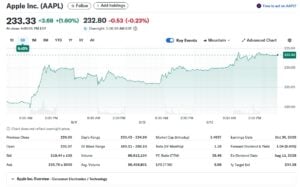
Let’s dive deeper into this:
$100 Billion Boost to American Manufacturing
Apple recently pledged an additional $100 billion to expand its U.S. manufacturing footprint, raising its total four-year American Manufacturing Program commitment to $600 billion. This plan includes opening new plants, offering supplier grants, and forming partnerships for key components like glass and chips.
The move is seen as a direct response to trade tensions with Washington, particularly past threats from President Donald Trump to impose a 25% tariff if iPhones weren’t made in the U.S. By increasing domestic production, Apple is improving its standing with policymakers and reducing the risk of costly import tariffs.
Key Partnerships Strengthen U.S. Supply Chain
As per media reports, the manufacturing expansion covers a broad network of U.S.-based suppliers and partners:
- Corning (GLW): Expanding smartphone glass production in Kentucky.
- Coherent (COHR): Producing VCSEL lasers for Face ID in Texas.
- TSMC, GlobalFoundries (GFS), and Texas Instruments (TXN): Collaborating on semiconductor production across Arizona, New York, Utah, and Texas.
- GlobalFoundries: Manufacturing wireless charging tech in New York.
Apple says this reshoring effort will enable an “end-to-end” chipmaking process in the U.S., from wafers to finished semiconductors. Over 19 billion chips for Apple products will be made domestically this year.
Rare Earth Partnership with MP Materials
Apple is also investing $500 million in MP Materials (NYSE: MP) to secure a long-term supply of rare earth magnets made entirely from recycled materials. These will be processed and manufactured in the U.S., supporting both supply chain resilience and Apple’s environmental commitments.
Apple’s Strong Earnings Fuel Investor Optimism
Apple’s latest earnings report added fuel to the rally. The company posted record June-quarter revenue of $94 billion—up 10% year over year. Product sales hit $66.6 billion, led by strong demand for the new iPhone 16 lineup and Mac computers.
Services revenue rose 13% to $27.4 billion, showing the company’s ability to diversify beyond hardware and generate steady, high-margin income.
- MORE DETAILS: Apple (AAPL Stock) Rings Up $94B Q3 Win Fueled by iPhones, AI Push, and Climate Smarts
Sustainability at the Core of Apple Products
Apple’s stock story also has a purpose. As per its latest sustainability report, in 2024, 24% of all product materials came from recycled or renewable sources, including:
- 99% recycled rare earth elements in magnets
- 99% recycled cobalt in batteries
- 100% recycled aluminum in many cases
Apple avoided 41 million metric tons of greenhouse gas emissions in 2024—equal to taking 9 million cars off the road. The company aims for a 75% emissions reduction from 2015 levels.
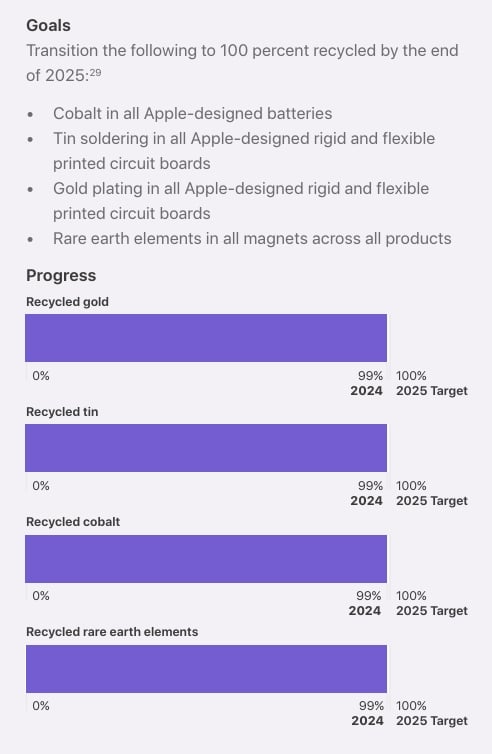
AI Partnerships Could Add Another Growth Driver
Reports suggest Apple is exploring partnerships with OpenAI and Anthropic to enhance Siri. If successful, these deals could strengthen Apple’s position in the fast-growing AI market.
Can U.S. Manufacturing Plans Keep the Rally Going?
Apple’s reshoring strategy could sustain momentum over the medium term. By resonating with Trump’s “America First” policies and reducing reliance on overseas suppliers, the company is lowering regulatory risks and earning political goodwill.
Nonetheless, challenges remain, but the long-term benefits could outweigh them by securing a more resilient supply chain.
From this analysis, it’s evident that Apple’s recent gains reflect a powerful combination of U.S. manufacturing investments, record earnings, sustainability leadership, and potential AI growth. By strategically aligning with domestic policy and building a stronger supply chain, the company is reducing uncertainty, which is one of the biggest drivers of investor confidence.
The post Apple: $94 Billion Record Earnings and the Breakthrough Climate Solutions Fueling Growth appeared first on Carbon Credits.
Carbon Footprint
U.S. DOE Reveals $1B Funding to Boost Critical Minerals Supply Chain
The U.S. Department of Energy (DOE) has announced a nearly $1 billion program to strengthen America’s supply of critical minerals and materials. The funding will support mining, processing, and manufacturing within the country. These materials power clean energy technologies and are vital for national security.
This funding builds on President Trump’s Executive Order to Unleash American Energy. It also supports the DOE’s wider Critical Minerals and Materials Program, which focuses on boosting U.S. production, expanding recycling, and strengthening supply chain security.
U.S. Secretary of Energy Chris Wright remarked:
“For too long, the United States has relied on foreign actors to supply and process the critical materials that are essential to modern life and our national security. Thanks to President Trump’s leadership, the Energy Department will play a leading role in reshoring the processing of critical materials and expanding our domestic supply of these indispensable resources.”
From Mines to Magnets: Where the $1B Goes
The DOE’s $1 billion plan targets key minerals like lithium, cobalt, nickel, and rare earth elements. These are essential for electric vehicle batteries, wind turbines, solar panels, and advanced electronics used in defense systems.
The funding is split across several areas:
- $500 million to the Office of Manufacturing and Energy Supply Chains (MESC) for battery material processing, manufacturing, and recycling projects.
- $250 million to the Office of Fossil Energy and Carbon Management to support facilities producing mineral byproducts from coal and other sources.
- $135 million to boost rare earth element production by extracting them from mining waste streams.
- $50 million to refine materials like gallium, germanium, and silicon carbide, which are crucial for semiconductors and high-performance electronics.
- $40 million through ARPA-E’s RECOVER program to extract minerals from industrial wastewater and other waste streams.
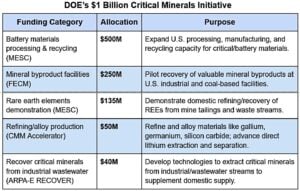
By investing from extraction to refining, the DOE aims to reduce reliance on foreign suppliers, especially those in politically unstable regions. The plan also encourages public–private partnerships to scale production faster.
Why Critical Minerals Matter for America’s Future
Critical minerals lie at the heart of America’s economic transformation and defense strategy. In recent years, demand for lithium, cobalt, nickel, and rare earth elements has grown. This rise comes as clean energy technologies become more important.
The U.S. imports more than 80% of its rare earth elements, and most of this comes from one country – China. This heavy reliance creates risks during trade or geopolitical tensions.
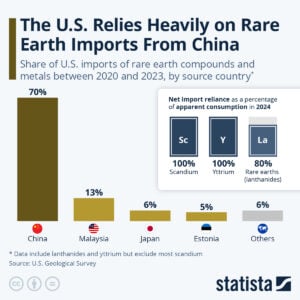
The Trump administration has placed strong emphasis on closing this vulnerability. In March 2025, an executive order highlighted critical minerals as vital for national defense. It also set timelines to boost U.S. production and processing capacity. This aligns with broader economic priorities, including clean energy jobs, green infrastructure, and domestic manufacturing.
The Inflation Reduction Act and infrastructure programs have unlocked billions in grants and tax credits. These funds support electric vehicle manufacturing, battery plants, and renewable energy projects.
The DOE’s $1 billion critical mineral fund supports programs by focusing on materials essential for the clean energy economy. Also, by reusing existing industrial facilities to recover minerals instead of building entirely new ones, the DOE can speed up progress and reduce costs.
EV production is expected to grow faster than any other sector, with demand for minerals likely to be more than 10x higher by 2050. This surge will transform the global supply chain and is critical for the global Net Zero aspirations.
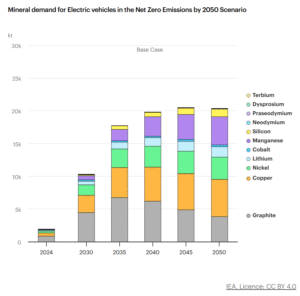
The combined impact of industrial strategy, financial incentives, and supply chain investments shows a clear push to:
- Move production back onshore,
- Boost innovation in materials recycling,
- Support the energy transition, and
- Cut down on foreign imports.
Building on Early Wins
The DOE’s new $1 billion investment boosts earlier funding for critical minerals. This aims to strengthen U.S. industrial capacity.
In 2023, the Department gave $150 million to various clean mineral projects. These include direct lithium extraction in Nevada and early-stage nickel processing partnerships in Oregon.
Since 2021, DOE has invested more than $58 million in research. This work focuses on recovering critical minerals from industrial waste or tailings. They are turning by-products into valuable feedstock.
These R&D projects created pilot facilities. They show how to recover lithium from geothermal brines and rare earths from coal ash. This approach models resource use without needing new mining.
Built on these early successes, the new $1 billion fund signals a shift from pilot programs to scaling proven technologies. It allows U.S. manufacturers to pivot from lab-scale experiments to full commercial operations.
For example, lithium recovery projects are moving from test sites to large extraction facilities. This shift is supported by the technical help from DOE’s national labs.
Likewise, battery recycling pilots are set to grow. More recycling centers are being planned in the Midwest and Southwest.
This funding approach provides continuity. It supports U.S. firms from basic research to commercialization. This helps them quickly move from proof-of-concept to production-ready operations. It also reassures private investors that government backing is strategic and sustained.
McKinsey projects that developing new copper and nickel projects will require between $250 billion and $350 billion by 2030. By 2050, the broader critical minerals sector could grow into a trillion-dollar market to support the net-zero or low-carbon transition.

Washington’s Backing, Industry’s Buy-In
Political backing for the domestic minerals strategy is strong. A recent executive order aims to speed up mining permits and provide federal support.
The Defense Department has also invested $400 million in MP Materials, the largest stakeholder in the only U.S. rare earth mine. This deal includes a new plant to produce magnets for electronics and defense applications.
Industry players are moving in the same direction. Battery maker Clarios is exploring sites for a $1 billion processing and recovery plant in the country. These moves show a shared goal between government and industry to rebuild America’s mineral supply chains.
Opportunities—and the Roadblocks Ahead
The DOE’s program offers major opportunities:
- Less reliance on foreign countries for essential materials.
- Creation of high-quality U.S. jobs.
- Growth in recycling and recovery technologies.
However, challenges remain. Mining and processing must be done without harming the environment. Technology costs need to stay competitive. And benefits must be shared fairly with local and Indigenous communities.
Amid all this, the global race for critical minerals is intensifying. Many countries are already securing their own supplies. The U.S. wants to close its supply gap and become a leader in clean energy manufacturing.
The DOE’s nearly $1 billion plan is a key step toward reshoring America’s critical minerals industry. It builds on earlier successes and aligns with private investments and new policies. If successful, it could make U.S. supply chains more secure, support the clean energy transition, and strengthen national security.
The post U.S. DOE Reveals $1B Funding to Boost Critical Minerals Supply Chain appeared first on Carbon Credits.
Carbon Footprint
Bitcoin Price Hits $124,000 Record High vs Ethereum Price Near $4,800: Which Crypto Is Greener?
Bitcoin price surged past $124,000 upon writing, setting a new all-time high. Analysts credit several factors:
- strong institutional buying,
- increased inflows into Bitcoin ETFs,
- favorable regulatory changes allowing crypto assets in 401(k) retirement accounts, and
- growing market optimism over expected Federal Reserve interest rate cuts.
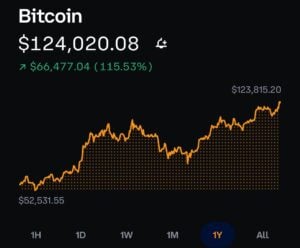
The rally reflects both a recovery from previous market downturns and a renewed appetite for digital assets among mainstream investors.
Ethereum, the second-largest cryptocurrency by market capitalization, is also on the rise. It is now approaching its all-time high of around $4,800, last seen in November 2021.
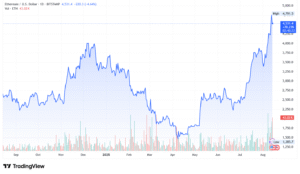
Investor sentiment is rising because of Ethereum’s role in decentralized finance (DeFi) and NFT marketplaces. Its better environmental profile, thanks to the switch to a proof-of-stake (PoS) model, also helps.
With both tokens in focus, let’s look at their energy use and carbon footprint. This matters for investors and policymakers who care about their climate and environmental impact.
How Bitcoin’s Proof-of-Work Consumes Energy
Bitcoin’s network runs on a process called proof-of-work (PoW). Miners around the world compete to solve complex mathematical puzzles. The first to solve it gets to add a block of transactions to the blockchain and earn newly minted Bitcoin. This process secures the network but demands enormous computing power.
That computing power uses a lot of electricity. Bitcoin’s annual energy use is estimated at about 138–178 terawatt-hours (TWh). This is similar to the electricity consumption of countries like Poland or Thailand, and even greater than Norway.
The carbon footprint is equally large, at around 40 million tonnes of CO₂ equivalent per year. To put that into perspective, that’s similar to the emissions of Greece or Switzerland.
On a per-transaction basis, a single Bitcoin payment can use as much energy as a typical U.S. household does in one to two months.
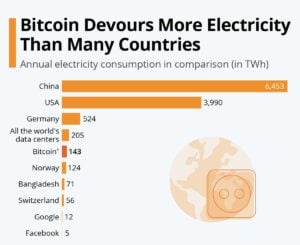
Beyond electricity, Bitcoin mining also generates significant electronic waste. Specialized mining hardware, called ASICs, becomes obsolete quickly—often within two to three years—because faster, more efficient models keep being developed. This turnover contributes thousands of tonnes of e-waste annually.
Ethereum’s Post-Merge Energy Transformation
Before 2022, Ethereum also used proof-of-work, with high energy demands. But in September 2022, the network completed the Merge, switching to proof-of-stake.
Ethereum now uses validators instead of miners. These validators “stake” their ETH tokens as collateral. This helps confirm transactions and secure the network.
This change cut Ethereum’s energy use by over 99.9%. Today, the network consumes an estimated 2,600 megawatt-hours (MWh) annually—roughly 0.0026 TWh. That’s less electricity than a small town of 2,000 homes might use in a year.
The carbon footprint is also tiny compared to Bitcoin—under 870 tonnes of CO₂ equivalent annually. That’s about the same as the yearly emissions of 100 average U.S. households. In environmental terms, Ethereum has gone from being one of the largest blockchain energy consumers to one of the most efficient.

Beyond Electricity: Hidden Environmental Costs
While electricity use is the biggest factor, it’s not the only environmental concern for both cryptocurrencies. Here are the other environmental impacts:
- Water Use:
Large-scale Bitcoin mining facilities often require substantial cooling, which can consume millions of liters of water annually. This can put pressure on local water supplies, particularly in drought-prone regions. Ethereum’s low energy profile greatly reduces such needs. - Heat Output:
Mining facilities generate significant heat. In some cases, waste heat is reused for industrial or agricultural purposes, but in most situations, it is simply released into the environment, adding to local thermal loads. - Land and Infrastructure:
Bitcoin mining operations require large warehouses and access to high-capacity electrical infrastructure. This can limit available industrial space for other uses and put stress on local grids.
By using proof-of-stake, Ethereum avoids most of these impacts. It just needs standard server equipment. This can run in data centers with other low-impact computing tasks.

How the Industry Is Addressing Bitcoin’s Footprint
The crypto industry is aware of Bitcoin’s environmental challenges and is taking steps to address them. Some of the actions taken include:
- Renewable Mining: Some mining operations use only hydro, wind, or solar energy. This is common in areas with plenty of renewable resources.
- Waste Heat Recovery: A few miners capture and reuse waste heat for agriculture (e.g., greenhouse farming) or district heating systems.
- Carbon Offsetting: Companies and mining pools are buying carbon credits to offset emissions. However, how well this works depends on the quality of those credits.
- Policy Proposals: Governments may require Bitcoin miners to share their energy sources or meet renewable energy goals.
SEE MORE: Top 5 Sustainable Bitcoin Mining Companies To Watch Out For
While these efforts are promising, the core challenge remains: proof-of-work’s high energy requirement is built into Bitcoin’s security model.
Why This Matters for ESG-Minded Investors
For investors who care about environmental, social, and governance (ESG) factors, the difference between Bitcoin and Ethereum is stark. Ethereum’s low-energy proof-of-stake model makes it easier to align with climate goals. Bitcoin’s high energy use and emissions, while partially mitigated by renewable adoption, remain a significant concern.
These factors may influence where ESG-focused funds allocate capital. Companies and institutions wanting exposure to blockchain technology without a large carbon footprint might prefer Ethereum or other PoS networks.
Bitcoin may still attract investors because of its market dominance and value as a store. However, it will likely keep facing environmental concerns.
The Road Ahead for Crypto and Climate
Bitcoin and Ethereum’s price rallies show that investor interest in crypto remains strong. As climate change and sustainability gain importance in policy and investment, environmental performance may play a larger role in the long-term value and acceptance of digital assets.
For now, Ethereum sets the standard for energy efficiency among major blockchains, while Bitcoin represents the ongoing challenge of balancing security, decentralization, and sustainability. Can Bitcoin cut its environmental impact without losing its key features? This will be an important question in the coming years.
The post Bitcoin Price Hits $124,000 Record High vs Ethereum Price Near $4,800: Which Crypto Is Greener? appeared first on Carbon Credits.
-
Climate Change2 years ago
Spanish-language misinformation on renewable energy spreads online, report shows
-
Climate Change Videos2 years ago
The toxic gas flares fuelling Nigeria’s climate change – BBC News
-

 Greenhouse Gases1 year ago
Greenhouse Gases1 year ago嘉宾来稿:满足中国增长的用电需求 光伏加储能“比新建煤电更实惠”
-

 Climate Change1 year ago
Climate Change1 year ago嘉宾来稿:满足中国增长的用电需求 光伏加储能“比新建煤电更实惠”
-

 Carbon Footprint1 year ago
Carbon Footprint1 year agoUS SEC’s Climate Disclosure Rules Spur Renewed Interest in Carbon Credits
-
Climate Change2 years ago
Why airlines are perfect targets for anti-greenwashing legal action
-
Climate Change Videos2 years ago
The toxic gas flares fuelling Nigeria’s climate change – BBC News
-
Climate Change2 years ago
Some firms unaware of England’s new single-use plastic ban



